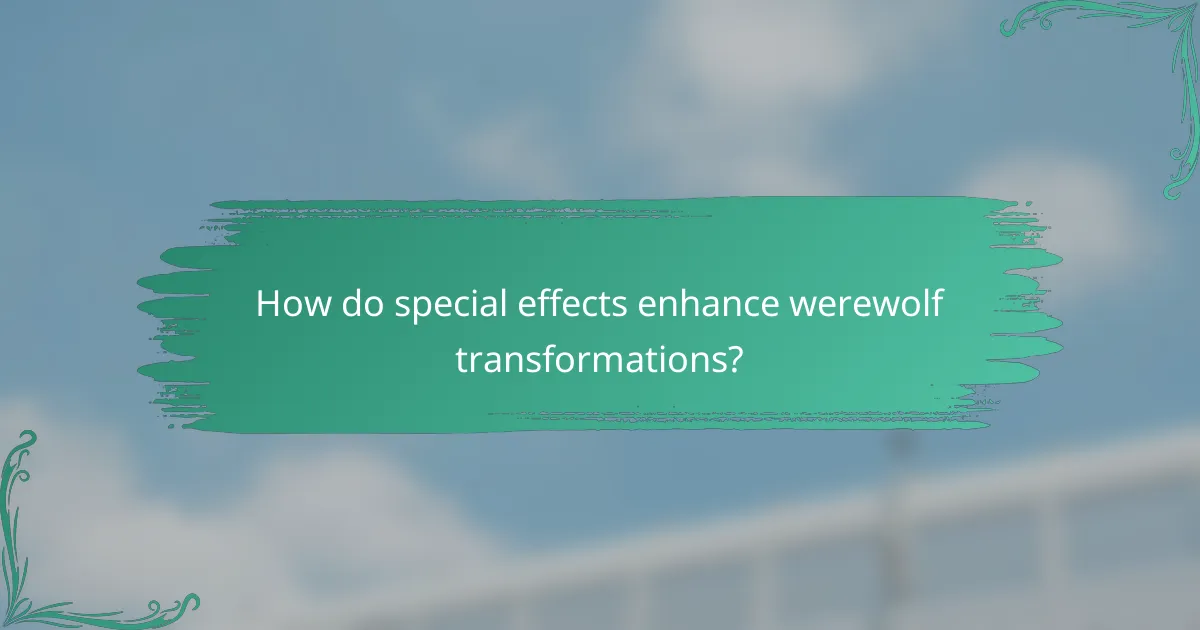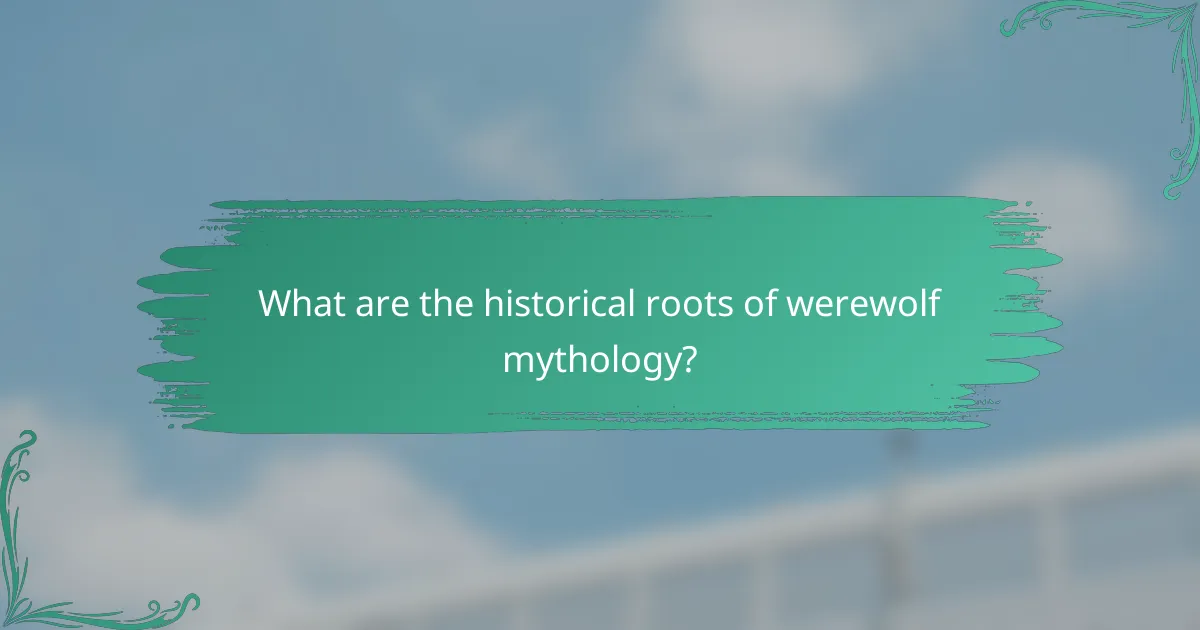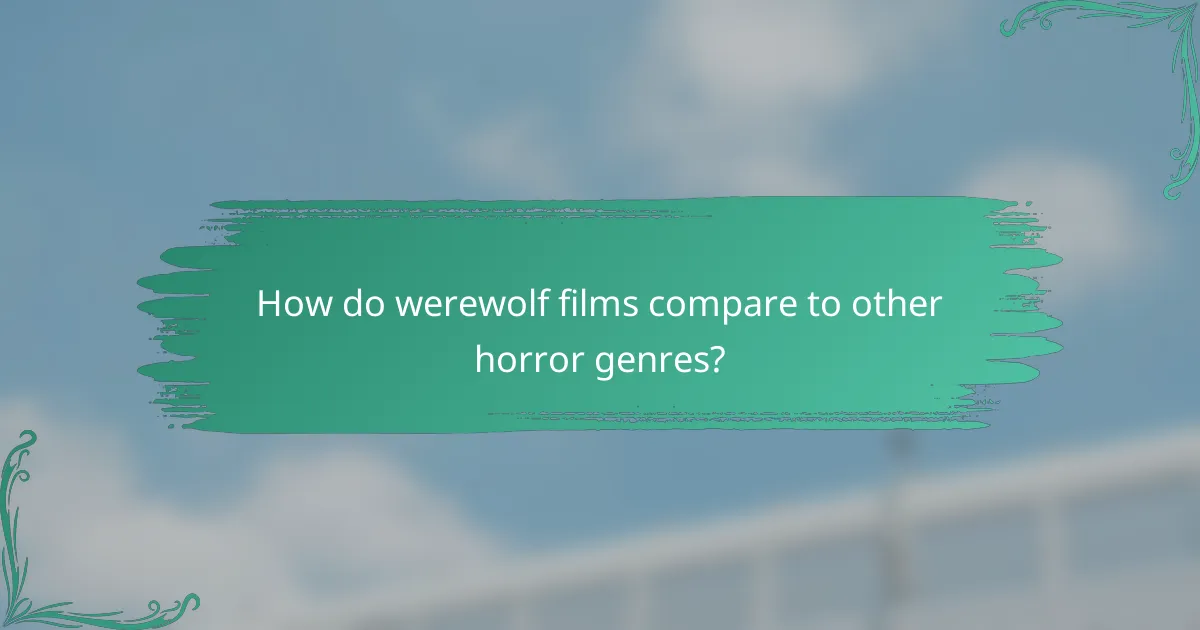Werewolf movies frequently intertwine traditional horror with science fiction, introducing advanced technology and speculative themes that enrich the narrative. This unique blend allows filmmakers to explore concepts such as genetic experimentation and the implications of scientific advancements on humanity, resulting in captivating storytelling. Special effects further enhance these films, creating striking transformations that leave a lasting impression on audiences.

How do werewolf movies incorporate sci-fi elements?
Werewolf movies often blend traditional horror with science fiction by introducing futuristic concepts, advanced technology, and hybrid narratives. This fusion creates a unique storytelling experience that enhances the transformation and lore surrounding werewolves.
Hybrid storytelling techniques
Hybrid storytelling in werewolf films combines elements from both horror and science fiction genres, allowing for innovative plots. For instance, narratives may intertwine the classic myth of lycanthropy with futuristic settings or dystopian themes, creating a richer backdrop for character development.
Examples include films where werewolves exist in a post-apocalyptic world, facing not only their primal instincts but also societal collapse. This approach can deepen the emotional stakes and provide commentary on human nature and survival.
Advanced technology in transformation
Advanced technology plays a significant role in the transformation process depicted in werewolf movies. Some films explore genetic engineering or experimental treatments that trigger lycanthropy, shifting the focus from supernatural to scientific explanations.
For example, a character might undergo a transformation due to a serum or a technological device, raising ethical questions about human enhancement and the consequences of playing with nature. This not only modernizes the myth but also invites viewers to ponder the implications of such advancements.
Alien influences on werewolf lore
Alien influences can reshape traditional werewolf lore by introducing extraterrestrial origins or characteristics. Some narratives suggest that werewolves are the result of alien experiments or that they possess abilities linked to otherworldly beings.
This perspective broadens the scope of werewolf mythology, allowing for creative interpretations that challenge the boundaries of human experience. Films that incorporate alien elements often explore themes of identity and otherness, making the werewolf a symbol of both fear and fascination.

What are notable werewolf movies with sci-fi themes?
Several werewolf movies incorporate sci-fi elements, blending horror with futuristic or speculative concepts. These films often explore themes of transformation, genetic experimentation, and the consequences of science on humanity.
Underworld series
The Underworld series is a prominent example of a werewolf movie that intertwines sci-fi with gothic horror. It features a war between vampires and lycans (werewolves), showcasing advanced technology and genetic manipulation that enhance the supernatural elements of the story.
Throughout the series, the lycans are depicted as more than just beasts; they are portrayed as a race with their own culture and technology. This blend of horror and science fiction allows for a deeper exploration of identity and conflict, making it a unique entry in the genre.
Dog Soldiers
Dog Soldiers combines military action with werewolf horror, presenting a group of soldiers on a training exercise that goes awry when they encounter a pack of werewolves. The film incorporates elements of survival and tactical combat, emphasizing the horror of facing a scientifically enhanced predator.
The sci-fi aspect is subtle but significant, as the werewolves are portrayed as a product of experimentation gone wrong, raising questions about the ethics of genetic manipulation. This film stands out for its intense action sequences and practical effects, making it a cult favorite among horror enthusiasts.
Altered States
Altered States is a unique film that explores the concept of transformation through the lens of science fiction, featuring a protagonist who uses sensory deprivation and hallucinogenic substances to explore human consciousness. While not a traditional werewolf movie, it delves into themes of metamorphosis and primal instincts.
The film’s exploration of the human psyche and its connection to animalistic behavior resonates with werewolf mythology, making it a thought-provoking addition to the genre. The blend of psychological horror and sci-fi elements invites viewers to consider the boundaries of human identity and evolution.

How do special effects enhance werewolf transformations?
Special effects play a crucial role in enhancing werewolf transformations by creating visually striking and believable metamorphoses. These effects can range from practical techniques to digital enhancements, each contributing to the overall impact of the transformation on screen.
Practical effects vs. CGI
Practical effects involve physical props, makeup, and animatronics to create transformations, often resulting in a more tactile and realistic appearance. Classic films like “An American Werewolf in London” showcased groundbreaking practical effects that captivated audiences with their authenticity.
On the other hand, CGI (computer-generated imagery) allows for more flexibility and creativity, enabling filmmakers to depict transformations that might be impossible with practical effects alone. However, CGI can sometimes feel less tangible, leading to mixed reactions from viewers.
Iconic transformation scenes
Iconic transformation scenes, such as those in “The Howling” and “Teen Wolf,” have become benchmarks in horror cinema. These sequences often blend practical effects and CGI to create memorable moments that leave a lasting impression on audiences.
For instance, the transformation scene in “An American Werewolf in London” is renowned for its innovative use of makeup and animatronics, setting a high standard for future films. Such scenes not only showcase the technical prowess of filmmakers but also enhance the emotional weight of the narrative.
Impact on audience immersion
The effectiveness of special effects in werewolf transformations significantly impacts audience immersion. When transformations are executed convincingly, viewers are more likely to suspend disbelief and engage with the story. This emotional connection is crucial in horror films, where fear and tension are paramount.
Conversely, poorly executed effects can break immersion, pulling viewers out of the experience. Filmmakers must strike a balance between realism and creativity to ensure that transformations resonate with the audience, enhancing their overall enjoyment of the film.

What are the historical roots of werewolf mythology?
Werewolf mythology has deep historical roots that trace back to ancient cultures, particularly in Europe. These legends often intertwine with folklore, ancient rituals, and societal fears, evolving over centuries into the modern interpretations seen in films today.
Folklore origins in Europe
The origins of werewolf folklore in Europe can be traced to various cultural beliefs and stories. Many European countries, such as Germany, France, and the Scandinavian nations, have rich traditions of shape-shifting tales, where individuals transform into wolves under specific conditions, often linked to the full moon.
These stories served as cautionary tales, warning against the dangers of straying from societal norms or engaging in immoral behavior. The werewolf became a symbol of the primal instincts lurking within humanity, reflecting fears of the unknown and the wild.
Connection to ancient rituals
Ancient rituals often played a significant role in the development of werewolf mythology. In some cultures, rites of passage or initiation ceremonies involved transformations that echoed the werewolf legend, emphasizing the connection between humans and animals.
For instance, certain tribes practiced shamanistic rituals where participants donned animal skins to invoke the spirit of the wolf, seeking strength and guidance. This blending of human and animal traits reinforced the idea of transformation and the duality of human nature.
Influence on modern cinema
The historical roots of werewolf mythology have significantly influenced modern cinema, shaping the portrayal of werewolves in films. Early cinematic adaptations often drew directly from European folklore, emphasizing the horror and tragedy of transformation.
As the genre evolved, filmmakers began to explore deeper themes, such as the struggle between humanity and primal instincts. Movies like “An American Werewolf in London” and “The Wolfman” highlight these themes, blending horror with dark humor and social commentary, showcasing how ancient myths continue to resonate in contemporary storytelling.

How do werewolf films compare to other horror genres?
Werewolf films often blend elements of horror with themes found in science fiction, setting them apart from other horror genres. They typically explore the duality of human nature, the struggle between civilization and primal instincts, and the consequences of transformation, which can resonate with sci-fi narratives.
Unique narrative structures
Werewolf films frequently employ a unique narrative structure that combines elements of folklore and modern storytelling. Many feature a protagonist who undergoes a transformation, creating a compelling arc that explores identity and morality. This contrasts with other horror genres, which may rely more heavily on straightforward survival plots or supernatural encounters.
For instance, films like “An American Werewolf in London” juxtapose humor with horror, allowing for a more complex narrative that engages viewers on multiple levels. This blending of genres can create a richer storytelling experience.
Character development differences
Character development in werewolf films often focuses on the internal conflict faced by the protagonist as they grapple with their transformation. This contrasts with other horror genres, where characters may be more archetypal and less nuanced. In werewolf narratives, the struggle between the human and beast within can lead to profound character growth or tragic downfall.
For example, in “The Wolfman,” the protagonist’s journey reflects themes of loss and redemption, allowing audiences to connect with their plight on a deeper emotional level. This depth of character is less common in slasher films, where characters often serve as mere plot devices.
Audience reception and expectations
Audience reception of werewolf films tends to be shaped by their expectations for both horror and sci-fi elements. Viewers often anticipate a blend of suspense, emotional depth, and philosophical questions about humanity. This differs from other horror genres, where audiences may primarily seek thrills or scares without the same level of introspection.
Films like “Ginger Snaps” have garnered a cult following due to their unique take on the werewolf mythos, appealing to viewers who appreciate character-driven stories. Understanding these expectations can help filmmakers craft narratives that resonate more effectively with their target audience.

What are the emerging trends in werewolf cinema?
Emerging trends in werewolf cinema include innovative storytelling techniques that blend traditional horror with modern themes. Filmmakers are increasingly incorporating elements from science fiction, psychological horror, and environmental narratives to create more engaging and thought-provoking experiences.
Integration of virtual reality experiences
Virtual reality (VR) is becoming a significant tool in werewolf cinema, allowing audiences to immerse themselves in the story. By using VR, viewers can experience the transformation and hunt from a first-person perspective, heightening the emotional impact of the narrative.
Films that incorporate VR elements often create interactive experiences where viewers can make choices that influence the outcome. This trend not only enhances engagement but also allows for a deeper exploration of the werewolf mythos.
Focus on psychological horror
Recent werewolf films are shifting towards psychological horror, emphasizing the internal struggles of characters rather than just the physical transformation. This approach explores themes of identity, fear, and the primal instincts that come with being a werewolf.
By focusing on psychological elements, filmmakers can create a more relatable and unsettling experience. This trend often leads to narratives that question the nature of humanity and the thin line between civilization and savagery.
Environmental themes in storytelling
Environmental themes are increasingly present in werewolf cinema, reflecting concerns about nature and humanity’s impact on the environment. Stories may depict werewolves as guardians of the forest or as symbols of nature’s wrath against human exploitation.
This trend allows filmmakers to weave important ecological messages into the horror genre, making the werewolf a metaphor for the consequences of environmental neglect. Such narratives resonate with audiences who are increasingly aware of climate issues and the need for conservation.
